固定收益证券-教学大纲-
- 格式:docx
- 大小:26.93 KB
- 文档页数:9
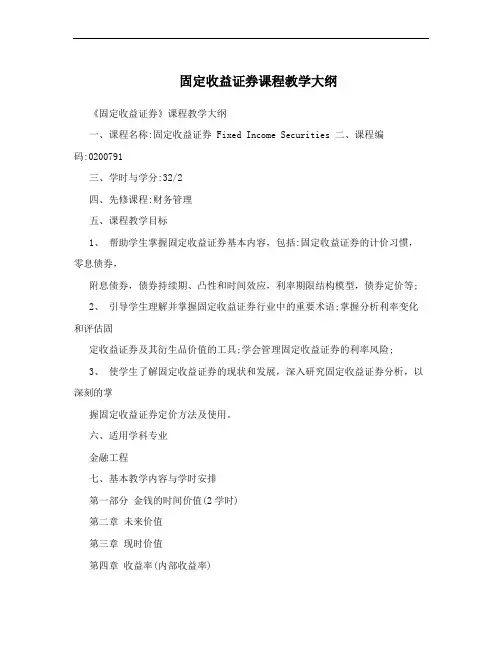
固定收益证券课程教学大纲《固定收益证券》课程教学大纲一、课程名称:固定收益证券 Fixed Income Securities 二、课程编码:0200791三、学时与学分:32/2四、先修课程:财务管理五、课程教学目标1、帮助学生掌握固定收益证券基本内容,包括:固定收益证券的计价习惯,零息债券,附息债券,债券持续期、凸性和时间效应,利率期限结构模型,债券定价等;2、引导学生理解并掌握固定收益证券行业中的重要术语;掌握分析利率变化和评估固定收益证券及其衍生品价值的工具;学会管理固定收益证券的利率风险;3、使学生了解固定收益证券的现状和发展,深入研究固定收益证券分析,以深刻的掌握固定收益证券定价方法及使用。
六、适用学科专业金融工程七、基本教学内容与学时安排第一部分金钱的时间价值(2学时)第二章未来价值第三章现时价值第四章收益率(内部收益率)第二部分无期权债的定价和收益率测度(6学时)第五章债券的价格第六章债券的传统收益率侧度第七章收益曲线、即期利率曲线和远期利率第三部分投资收益分析(4学时)第八章潜在的美元收益来源第九章总收益率第十章测量历史业绩第四部分无期债券的价格波动率(8学时)第十一章无期债券的价格波动率特性第十二章价格波动率测度:PVBP和价格变化的YV第十三章价格波动率测度:久期第十四章价格波动率测度:凸性第十五章久期与收益曲线第五部分分析含内嵌期权的债券(6学时)第十六章买权:投资特征和价格特征第十七章含内嵌期权的债券的定价和价格波动率第六部分(略) 第七部分统计和优化技术(4学时)概率理论第二十一章第二十二章模拟第二十三章回归分析第二十四章优化模型八、教材及参考书弗兰克. J. 法博齐 (美) 著,俞卓菁译,固定收益数学:分析与统计技术,上海人民出版社,2005。
九、考核方式书面考试、作业。
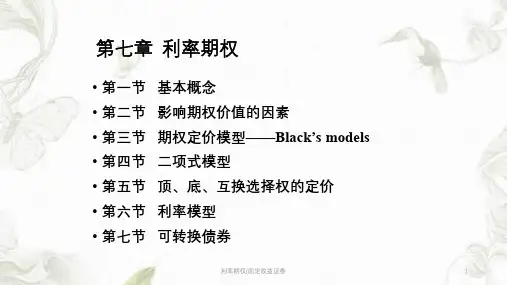
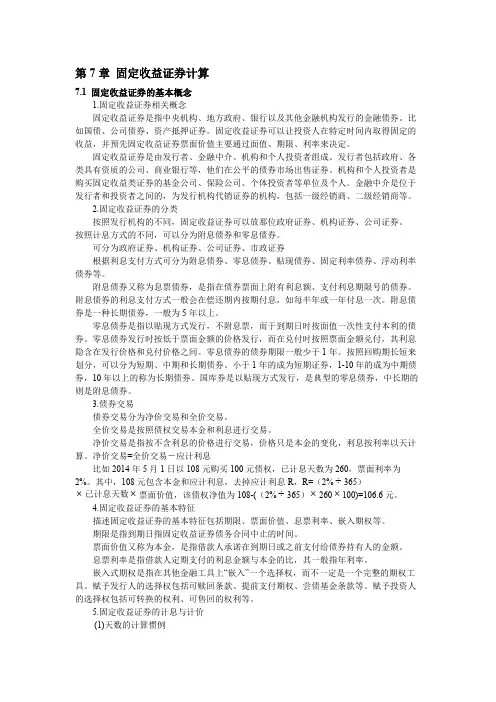
第7章固定收益证券计算7.1 固定收益证券的基本概念1.固定收益证券相关概念固定收益证券是指中央机构、地方政府、银行以及其他金融机构发行的金融债券。
比如国债、公司债券、资产抵押证券。
固定收益证券可以让投资人在特定时间内取得固定的收益,并预先固定收益证券票面价值主要通过面值、期限、利率来决定。
固定收益证券是由发行者、金融中介、机构和个人投资者组成。
发行者包括政府、各类具有资质的公司、商业银行等,他们在公平的债券市场出售证券。
机构和个人投资者是购买固定收益类证券的基金公司、保险公司、个体投资者等单位及个人。
金融中介是位于发行者和投资者之间的,为发行机构代销证券的机构,包括一级经销商、二级经销商等。
2.固定收益证券的分类按照发行机构的不同,固定收益证券可以放那位政府证券、机构证券、公司证券。
按照计息方式的不同,可以分为附息债券和零息债券。
可分为政府证券、机构证券、公司证券、市政证券根据利息支付方式可分为附息债券、零息债券、贴现债券、固定利率债券、浮动利率债券等。
附息债券又称为息票债券,是指在债券票面上附有利息额、支付利息期限号的债券。
附息债券的利息支付方式一般会在偿还期内按期付息,如每半年或一年付息一次。
附息债券是一种长期债券,一般为5年以上。
零息债券是指以贴现方式发行,不附息票,而于到期日时按面值一次性支付本利的债券。
零息债券发行时按低于票面金额的价格发行,而在兑付时按照票面金额兑付,其利息隐含在发行价格和兑付价格之间。
零息债券的债券期限一般少于1年。
按照回购期长短来划分,可以分为短期、中期和长期债券。
小于1年的成为短期证券,1-10年的成为中期债券,10年以上的称为长期债券。
国库券是以贴现方式发行,是典型的零息债券,中长期的则是附息债券。
3.债券交易债券交易分为净价交易和全价交易。
全价交易是按照债权交易本金和利息进行交易。
净价交易是指按不含利息的价格进行交易,价格只是本金的变化,利息按利率以天计算。

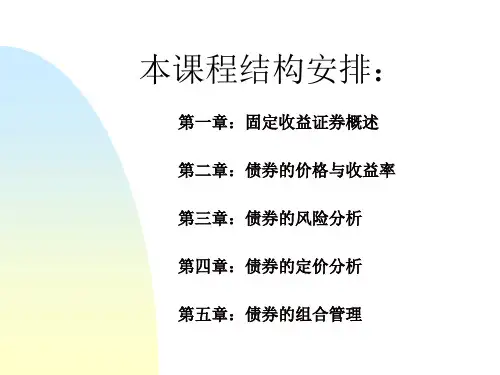

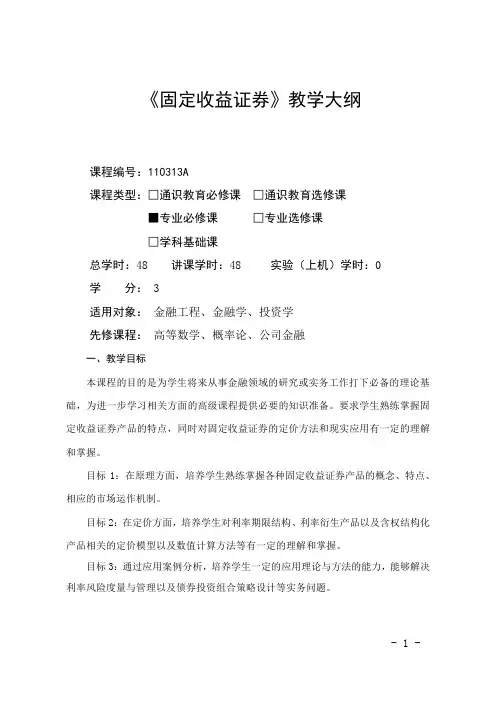
《固定收益证券》教学大纲课程编号:110313A课程类型:□通识教育必修课□通识教育选修课■专业必修课□专业选修课□学科基础课总学时:48 讲课学时:48实验(上机)学时:0学分:3适用对象:金融工程、金融学、投资学先修课程:高等数学、概率论、公司金融一、教学目标本课程的目的是为学生将来从事金融领域的研究或实务工作打下必备的理论基础,为进一步学习相关方面的高级课程提供必要的知识准备。
要求学生熟练掌握固定收益证券产品的特点,同时对固定收益证券的定价方法和现实应用有一定的理解和掌握。
目标1:在原理方面,培养学生熟练掌握各种固定收益证券产品的概念、特点、相应的市场运作机制。
目标2:在定价方面,培养学生对利率期限结构、利率衍生产品以及含权结构化产品相关的定价模型以及数值计算方法等有一定的理解和掌握。
目标3:通过应用案例分析,培养学生一定的应用理论与方法的能力,能够解决利率风险度量与管理以及债券投资组合策略设计等实务问题。
二、教学内容及其与毕业要求的对应关系本课程的主要内容包括介绍各种固定收益证券产品的概念、特点、相应的市场运作机制;讲解利率期限结构、利率衍生产品以及含权结构化产品相关的定价模型以及数值计算方法;通过应用案例分析,介绍利率风险度量与管理以及债券投资组合策略设计等实务问题。
通过对固定收益证券的基本原理以及定价方法的讲授,使学生系统掌握固定收益产品定价的基本原理以及相关技术,熟悉该领域的主要研究成果和最新研究动态。
通过应用案例分析,培养学生一定的应用能力,能够解决利率风险度量与管理以及债券投资组合策略设计等实务问题。
通过对发达国家债券市场以及相关衍生品、资产证券化等最新发展的介绍,使学生熟悉国际市场的最新动态和惯例,拓展学生的国际视野。
三、各教学环节学时分配以表格方式表现各章节的学时分配,表格如下:教学课时分配四、教学内容第一章固定收益证券概述第一节理解固定收益证券第二节基础性债务工具第三节固定收益证券衍生品第四节结构性债务工具第五节固定收益证券市场教学重点、难点:固定收益证券的分类以及风险特征、资产证券化。

固定收益证券课程设计一、课程目标知识目标:1. 理解固定收益证券的基本概念、分类及特点;2. 掌握固定收益证券的估值、定价及风险分析方法;3. 了解固定收益证券市场的运行机制及主要参与主体。
技能目标:1. 能够运用固定收益证券的基本分析和技术分析方法,进行投资决策;2. 培养学生搜集、整理和分析固定收益证券相关数据的能力;3. 提高学生解决固定收益证券投资实践中问题的能力。
情感态度价值观目标:1. 培养学生对固定收益证券投资的兴趣和热情;2. 培养学生严谨、客观、理性的投资态度,遵循市场规律,遵循价值投资原则;3. 增强学生的风险意识,培养学生具有良好的投资风险控制能力。
课程性质:本课程为金融学相关专业的选修课程,旨在帮助学生掌握固定收益证券的基本理论、分析方法及投资技巧。
学生特点:学生具备一定的金融市场基础知识,对固定收益证券有一定了解,但对具体投资分析和操作尚不熟练。
教学要求:结合实际案例,注重理论联系实际,提高学生的实际操作能力;采用启发式教学,引导学生主动探究,培养其独立思考和解决问题的能力;注重培养学生的风险意识和投资道德。
通过本课程的学习,使学生在知识、技能和情感态度价值观方面取得具体的学习成果。
二、教学内容1. 固定收益证券概述- 证券市场结构与固定收益证券的分类- 固定收益证券的特点及与其他金融工具的区别2. 固定收益证券的估值与定价- 利率期限结构及其应用- 债券估值方法及影响因素- 债券定价模型及其应用3. 固定收益证券的风险与收益分析- 信用风险、利率风险及流动性风险- 收益率、久期及凸度- 风险收益权衡及风险管理4. 固定收益证券投资策略- 主动投资与被动投资策略- 不同市场环境下的投资策略分析- 投资组合构建与优化5. 固定收益证券市场实践- 债券发行与交易流程- 债券市场指数及债券基金- 固定收益证券投资案例分析教学内容安排与进度:第1周:固定收益证券概述第2-3周:固定收益证券的估值与定价第4-5周:固定收益证券的风险与收益分析第6-7周:固定收益证券投资策略第8周:固定收益证券市场实践本教学内容根据课程目标,遵循科学性和系统性原则,结合教材相关章节,确保学生在掌握基本理论的基础上,能够深入了解固定收益证券的投资实践。

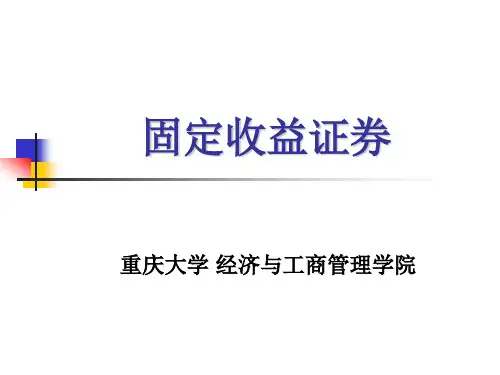
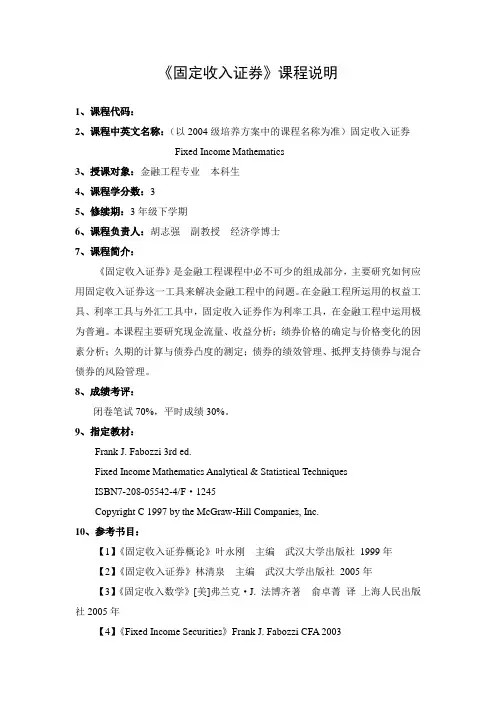
《固定收入证券》课程说明
1、课程代码:
2、课程中英文名称:(以2004级培养方案中的课程名称为准)固定收入证券
Fixed Income Mathematics
3、授课对象:金融工程专业本科生
4、课程学分数:3
5、修续期:3年级下学期
6、课程负责人:胡志强副教授经济学博士
7、课程简介:
《固定收入证券》是金融工程课程中必不可少的组成部分,主要研究如何应用固定收入证券这一工具来解决金融工程中的问题。
在金融工程所运用的权益工具、利率工具与外汇工具中,固定收入证券作为利率工具,在金融工程中运用极为普遍。
本课程主要研究现金流量、收益分析;绩券价格的确定与价格变化的因素分析;久期的计算与债券凸度的测定;债券的绩效管理、抵押支持债券与混合债券的风险管理。
8、成绩考评:
闭卷笔试70%,平时成绩30%。
9、指定教材:
Frank J. Fabozzi 3rd ed.
Fixed Income Mathematics Analytical & Statistical Techniques
ISBN7-208-05542-4/F·1245
Copyright C 1997 by the McGraw-Hill Companies, Inc.
10、参考书目:
【1】《固定收入证券概论》叶永刚主编武汉大学出版社1999年
【2】《固定收入证券》林清泉主编武汉大学出版社2005年
【3】《固定收入数学》[美]弗兰克·J. 法博齐著俞卓菁译上海人民出版社2005年
【4】《Fixed Income Securities》Frank J. Fabozzi CFA 2003。
《固定收益证券》课程教学大纲(2004年制定,2006年修订)课程编号:050162英文名:Fixed Income Securities课程类型:专业主干课前置课:证券投资学、公司财务后置课:金融衍生工具学分:3学分课时:54课时主讲教师:华仁海等选定教材:汤震宇等~固定收益证券定价理论~北京:复旦大学出版社~2004. 课程概述:《固定收益证券》是金融工程专业的一门专业主干课程。
固定收益证券是一大类重要金融工具的总称,其主要代表是国债、公司债券、资产抵押证券等。
固定收益证券包含了违约风险、利率风险、流动性风险、税收风险和购买力风险。
本课程主要讲授固定收益证券的计价习惯,零息债券,附息债券,债券持续期、凸性和时间效应,利率期限结构模型,含权债券定价,利率期货、期权和互换的定价,住房贷款支撑证券(MBS)等。
教学目的:通过本课程的学习,使学生了解固定收益证券方面的基本知识,掌握固定收益证券行业中的重要术语;掌握分析利率变化和评估固定收益证券及其衍生品价值的工具;学会管理固定收益证券的利率风险;掌握确定债券选择权或者暗含选择权的最佳执行策略。
教学方法:本课程主要以课堂讲授为主,并采取课件辅助教学。
各章教学要求及教学要点第一章货币的时间价值课时分配:4课时教学要求:通过本章学习,使学生掌握货币的时间价值概念、会计核算、现金流的现值和终值。
教学内容:第一节货币时间价值的计算一、单利的计算。
(一)单利利息的计算。
(二)单利终值的计算。
(三)单利现值的计算。
二、复利的计算。
(一)复利终值。
(二)复利现值。
(三)复利息。
(四)名义利率与实际利率。
三、年金的计算。
(一)普通年金。
1、普通年金的终值计算。
2、偿债基金。
3、普通年金的现值计算。
(二)预付年金。
1、预付年金终值计算。
2、预付年金现值计算。
3、递延年金。
4、永续年金。
思考题:1、什么是货币的时间价值,如何计算,2、单利和复利的区别,3、如何计算年金的现值和终值,第二章固定收益证券特性课时分配:7课时教学要求:通过本章学习,使学生了解固定收益证券的特征,了解固定收益证券的各种测度,掌握不同证券价格情况下当前收益率、到期收益率和票面收益率的关系,了解中国债券市场的历史、现状和特点。
固定收益证券教学大纲固定收益证券教学大纲一、引言固定收益证券是金融市场中的一种重要资产类别,其特点是在购买时就确定了一定的收益和到期时间。
本文将围绕固定收益证券的基本概念、种类、定价和风险等方面进行探讨,以帮助读者全面了解固定收益证券。
二、基本概念固定收益证券是指在购买时就确定了一定的利息收益和到期时间的金融工具。
常见的固定收益证券包括国债、企业债券、资产支持证券等。
它们通常具有较低的风险和较稳定的收益,因此受到投资者的青睐。
三、固定收益证券的种类1. 国债国债是国家借款发行的债券,通常由政府发行,具有较高的信用等级和较低的违约风险。
国债的收益以利息形式支付,到期时偿还本金。
2. 企业债券企业债券是企业借款发行的债券,用于筹集资金。
企业债券的收益和到期时间由债券发行时确定,通常具有较高的利率和一定的风险。
3. 资产支持证券资产支持证券是以特定资产为支撑的债券,常见的有抵押贷款支持证券和车贷支持证券等。
它们的收益和风险与支撑的资产直接相关。
四、固定收益证券的定价固定收益证券的定价涉及到现值计算和利率的影响。
通常情况下,利率越高,证券的现值越低;利率越低,证券的现值越高。
此外,到期时间、债券的信用等级和市场需求等因素也会影响证券的定价。
五、固定收益证券的风险固定收益证券虽然具有较低的风险,但仍然存在一定的风险。
其中,利率风险是最主要的风险之一。
当市场利率上升时,已经发行的固定收益证券的市场价格会下降,从而导致投资者持有的证券价值减少。
六、固定收益证券的投资策略在投资固定收益证券时,投资者可以采取一些策略来降低风险和提高收益。
例如,通过分散投资来降低单一债券违约的风险;通过选择信用等级较高的债券来降低信用风险等。
七、结论固定收益证券作为金融市场中的重要资产类别,具有较低的风险和较稳定的收益。
了解固定收益证券的基本概念、种类、定价和风险等方面,对投资者进行合理的投资决策具有重要意义。
在实际投资中,投资者应根据自身的风险承受能力和投资目标,选择适合自己的固定收益证券投资策略。
《固定收益证券》课程教学大纲(供制订教学大纲时参考)一、课程名称:固定收益证券Fixed-Income Security二、课程编码:三、学时与学分:32/2四、先修课程:无五、课程教学目标1. 帮助学生获得必要的固定收益证券相关知识,了解金融学科发展前沿,掌握探索固定收益证券基本规律的一般方法;2. 引导学生接受固定收益证券知识熏陶,提高金融基本素养;3. 使学生了解人在金融市场的地位和作用,培养正确的投资观,增强社会责任感,促进全面素质的提高。
六、适用学科专业金融学、金融工程七、基本教学内容与学时安排●世界固定收益市场概述(4学时)全球固定收益市场概览美国的固定收益市场欧洲固定收益市场日本的固定收益市场●价格、贴现因子和套利(2学时)定义计算●固定利率的付息国债的现金流(2学时)●贴现因子(2学时)一价定律●套利和一价定律(2学时)●应用案例研究(2学时)本息剥离债券和美国中长期国债的个性定价应计利息●即期利率、远期利率和平价利率(4学时)定义单利和复利计算●由利率互换提取贴现因子(2学时)●即期利率、远期利率和平价利率(2学时)定义特征计算●交易案例研究(2学时)2010年第2季度在10s-30s期限段异常向下倾斜的欧元远期利率曲线及交易策略●回报率、利率差和收益率(4学时)定义计算收益和损失的分解与回报率●Carry-Roll-Down情景分析(4学时)八、教学方法九、教材及参考书(请详细一些)●固定收益证券(第三版),[美]布鲁斯·塔克曼(Bruce Tuckman),[美] 安杰尔·塞拉特(Angel Serrat)著,范龙振,林祥亮,戴思聪等译,机械工业出版社,2014年十、课程考核方式平时成绩(40%)+论文(60%)。
《固定收益证券》教学大纲“Fixed Income Securities” Syllabus课程编号:150092B课程类型:专业选修课总学时:32 讲课学时:32 实验(上机)学时:0学分:2适用对象:金融学(金融经济)先修课程:无Course code: 150092BCourse Type: Optional field courseCredit hours: 32 Lectures: 32 Practice: 0Credits: 2Major: Finance(Finance and Economics Experimental Class)Prerequisite: None一、课程的教学目标(Learning objective)固定收益证券是金融类专业本科生的专业课。
其在行业内的重要性体现在以下三点:第一,目前是全球交易的金融资产中固定收益证券比重最大。
其次,机构投资者,比如银行、养老基金或是共同基金所设计的投资组合中固定收益证券和利率的衍生工具占比最大。
最后,理解利率的变化并对其建模是实行好的风险管理的重要前提。
该课程的教学对培养与训练学生金融学思维方式,提高其综合素质和能力有非常重要的意义。
本课程教学的主要目标是培养学生掌握固定收益类证券的基本理论知识,使学生能够将所学知识应用到将来所从事的金融证券行业的工作中去,或为本科以后阶段的学习打下坚实的理论基础。
Fixed income securities is a field course in Finance major. The course is an important course for three reasons. First, fixed income securities constitute by far the largest portion of globally traded assets. Institutional investors, such as banks, pension funds or mutual funds, have most of its trading portfolio composed of fixed income securities (treasury bills and bonds) and interest rate derivatives. Second, in developed financial markets, a significant part of capital for business is raised through issuing of corporate bonds. Last, but not least, proper understanding of changes in the interest rates and the ability to model them is a prerequisite for a good risk management. The instruction of fixed income securities plays very important role in building up students’ thinking as a practitioner in finance industry for the learners, and improving their comprehensive abilities to work and study. The aim of this course is to help student understand the basic theories and knowledge of fixed income securities, and apply the knowledge in this course to their future work in finance industry; or be well prepared for their future study in this field.二、教学基本要求(Teaching requirements)(一)教学内容(teaching materials)这门课主要覆盖了以下十部分内容:(1)固定收益证券的概念、债券的种类。
(2)债券发行市场、流通市场、债券交易、债券评级。
(3)货币的时间价值、债券价值、复杂情况下债券价值等的计算。
(4)债券收益率。
(5)凸性和久期的概念,票面利率大小、到期时间、初始收益率与债券价格波动的关系。
(6)名义利率决定理论、利率期限结构理论。
(7)利率期货、利率期权、利率掉期。
(8)利率衍生工具的定价。
(9)可转换债券定价与收益分析。
(10)债券投资组合管理策略。
The course covers (1) the concept of fixed-income securities, types of bond. (2) bond issue market, secondary market, bond trading, bond rating. (3) the time value of money, bonds’ value,the calculation of bond value under complex conditions. (4) bonds yields. (5) concept of convexity and duration, relationship of the coupon rate, maturity time, initial yield to bond price volatility.(6) the theory on nominal interest rate decision, on the interest rate term structure. (7) interest rate futures, interest rate options, interest rate swaps. (8) pricing of interest rate derivatives. (9) the analysis of convertible bond’s pricing and yield. (10) Bond portfolio management strategies.(二)教学方法和手段这门课理论性较强,以理论教授为主,学生练习为辅。
同时安排“读、写、议”课堂以便学生能够深入理解基本原理;组织学生分组进行主题课堂讨论。
The course is mainly theoretical. The main teaching technique will be lecturing companied by students’ tutorial presentation. The class will involve reading, writing and discussion to help students fully understand the course materials. In-class group presentation will also be important parts of the course.(三)考核方式(Assessment and Grading)该科满分一百,由以下各部分按不同权重组成。
The total score is 100,the weight of different parts is as followed.类别(Components)权重(Weight)平时成绩(Coursework)30%1. 随堂小测验(In-Class Quiz) 15%2. 课堂讲演(Tutorial Presentation) 15%闭卷期末考试(Final Exam)70%总共(Total)100%三、各教学环节学时分配(Course schedule)教学课时分配Class schedule四、教学内容(Teaching materials)第一章货币的时间价值1. 市场利率的决定因素2. 利率的类型3. 现值和终值4. 年金和永续年金5. 非等额现金流重点、难点:市场利率,现值和终值,金融计算器考核要求:掌握市场利率的决定因素;掌握现金流、现值和终值的关系;掌握金融计算器的使用方法Lecture 1 Time Value of Money1.The Determinants of Market Interest Rates2.Classification of Interest Rates3.Present Values and Future Values4.Annuities and Perpetuities5.Uneven Cash FlowsKey Points: market interest rates, cash flows, present values and future values, financial calculatorOutcome: grasp the determinants of interest rates; grasp the relation among present value, future value and cash flows; understand how to use a financial calculator第二章固定收益证券及其市场概述1.债券特点概述2.美国国债和国库券3.美国州政府债4.公司债重点、难点:债券特点,发行人类别,嵌入期权式债券,债券投资风险考核要求:理解债券市场的主要构成部分;理解债券的主要种类及各自的特点Lecture 2 Introduction to Fixed Income Securities and Markets1.Overview of Bond Features2.U.S. Treasury and Federal Agency Securities3.U.S. Municipal Securities4.Corporate Debt InstrumentsKey Points: features of bonds, types of issuers, bonds with an embedded option, types of risks faced by investors in fixed-income securitiesOutcome: understand the components of fixed income securities markets; understand types of bonds and their features第三章债券定价及收益率1.债券定价2.价格收益率关系3.到期收益率4.年化收益率和有效收益率5.债券的回报6.非债券付息日的债券定价重点、难点:债券定价,到期收益率,应计利息,标价考核要求:掌握债券定价;掌握到期收益率的计算;理解价格收益率曲线;理解应计利息和标价Lecture 3 Bond Price and Yield1.Pricing a Bond2.Price-Yield Relationship3.Yield to Maturity4.Annualized and Effective Yields5.Total Return of a Bond6.Pricing a Bond between Coupons Payment DatesKey Points: pricing a bond, yield to maturity, accrued interest, quoted priceOutcome: grasp the calculation of the price of a bond; grasp the calculation of yield to maturity; understand the price-yield relationship; understand the concept of accrued interest and quoted price第四章债券价格波动及其衡量指标1.债券价格波动的特点2.久期3.凸度4.用久期和凸度估计债券价格的变动重点、难点:债券价格波动,久期,凸度,有效久期和凸度,价格变化估计考核要求:理解债券价格波动;掌握久期,凸度的计算;掌握用久期和凸度估计债券价格变动的方法Lecture 4 Bond Price Volatility1.Price Volatility Characteristics of Option-Free Bonds2.Duration3.Convexity4.Approximating price change using Duration and ConvexityKey Points: price volatility, duration, convexity, effective measures, approximating bond price changeOutcome: understand what is price volatility; grasp the calculation of duration and convexity; grasp the approximation of bond price using duration and convexity第五章利率的期限结构I1.基础利率和基准利差2.即期利率3.构造即期利率曲线重点、难点:基础利率,利差,即期利率,自助法考核要求:理解基础利率,利差以及它们与其他利率的关系;理解即期利率;掌握构造即期利率曲线的方法Lecture 5 Term Structure of Interest Rate I1.Base Interest Rate and Benchmark Spread2.Spot Rate3.Constructing the Theoretical Spot Rate CurveKey Points: base interest rate, spread, spot rate, bootstrapOutcome: understand base interest rate, spread and their relation with other interest rate; understand spot rate; grasp the construction of the theoretical spot rate curve第六章利率的期限结构II1.利用即期利率给债券定价2.远期利率3.利率期限结构的决定因素重点、难点:远期利率,掉期利率,LIBOR利率考核要求:掌握利用即期利率或远期利率给债券定价的方法;理解利率期限结构的决定因素及曲线的形状;理解掉期利率和LIBOR利率的概念Lecture 6 Term Structure of Interest Rate IIing Spot Rate Curve to Price a bond2.Forward Rate3.Determinants of Term Structure4.the swap curve/LIBOR curveKey Points: forward rate, swap rate, LIBOR rateOutcome: grasp the pricing of bond using spot rate or forward rate; understand the determinants and shape of term structure; understand the concept of swap rate and LIBOR rate第七章利率模型(期限结构模型)1.利率模型的特点:漂移,波动和均值回归2.单因子利率模型3.无套利模型和均衡模型4.利率变化的经验证据重点、难点:利率二叉树,利率模型,漂移,波动,均值回归,单因子,无套利,均衡考核要求:了解利率模型的基础知识;理解无套利模型和均衡模型的关系;了解利率变化的经验研究证据Lecture 7 Interest-rate model (term structure model)1.Characteristics of an interest-rate model: drift, volatility, and mean reversion2.One-factor interest-rate models3.Arbitrage-free model and equilibrium model4.The empirical evidence on interest rate changesKey Points: binominal interest rate trees, interest-rate model, drift, volatility, mean reversion, one-factor, arbitrage, equilibriumOutcome: understand the basis of interest-rate models; understand the relation betweenarbitrage-free model and equilibrium model; understand the empirical evidence on interest rate models第八章嵌入期权式债券分析I1.期权的特点2.可召回债券的特点3.嵌入期权式债券的定价重点、难点:嵌入式期权,可召回,可卖出,可转,期权定价考核要求:了解嵌入期权式债券和普通债券的区别;理解期权式债券的主要类别;掌握嵌入期权式债券的定价Lecture 8 Analysis of Bonds with Embedded Options I1.Characteristic of Options2.Features of Callable Bonds3.Pricing of A Bond with Embedded OptionsKey Points: embedded options, callable, putable, convertible, option pricingOutcome: understand the difference between bonds with embedded options and option-free bonds; understand the typical bonds with embedded options; grasp the pricing of a bond with embedded options第九章嵌入期权式债券分析II1.期权调整利差2.有效久期和凸度3.可转债重点、难点:期权调整利差,可转债考核要求:了解期权调整利差的概念;掌握可转债和股票的关系Lecture 9 Analysis of Bonds with Embedded Options II1.Option-Adjusted Spread2.Effective Duration and Convexity3.Features of Convertible BondsKey Points: option-adjusted spread, convertible bondsOutcome: understand the concept of option-adjusted spread; grasp the relation between convertible bonds and stocks第十章住房抵押贷款证券1.住房抵押贷款2.住房抵押贷款支持证券市场3.抵押转递证券重点、难点:住房抵押贷款,住房抵押贷款支持证券考核要求:理解住房抵押贷款及其种类;理解按揭的概念及住房抵押贷款的风险;理解住房抵押贷款支持证券和抵押转递证券的概念Lecture 10 Residential Mortgage-Backed Securities1.Residential Mortgage Loans2.Residential Mortgage-Backed Securities Markets3.Characteristics of Mortgage Pass-Through SecuritiesKey points: residential mortgage loans; mortgage-backed securitiesOutcome: understand a mortgage loan and types of residential mortgage loans; understand a prepayment and risks associated with investing in mortgages; understand the concepts of amortgage-backed security and a mortgage pass-through security第十一章抵押担保债券1.抵押担保债券2.信贷资产证券的产生3.担保类型及证券化结构4.担保债务凭证重点、难点:抵押担保债券,信贷资产证券,担保债务凭证考核要求:了解抵押担保债券的来由;理解序列型抵押担保债券的概念;理解信贷资产证券是如何产生的;了解证券化的基本结构;了解担保债务凭证的概念及其种类Lecture 11 Collateralized Mortgage Obligations1.Characteristics of Collateralized Mortgage Obligations2.Creation of an ABS3.Collateral Type and Securitization Structure4.Collateralized Debt ObligationsKey Points: collateralized mortgage obligation; asset-backed securities; collateralized debt obligationOutcome: understand why and how an agency collateralized mortgage obligation is created; understand what a sequential-pay CMO is; understand how asset-backed securities are created; understand the basic structure of a securitization; understand what is meant by a collateralized debt obligation, collateralized bond obligation, and collateralized loan obligation第十二章利率期货1.利率期货2.利率期货市场的定价和套利3.利率期货在债券投资组合管理里的应用重点、难点:期货,最低交割价,利率期货合约价格考核要求:理解期货合约及其与远期合约的不同;理解利率期货的基本特点;理解利率期货合约的理论定价;理解利率期货在债券投资组合管理里的应用Lecture 12 Interest Rate Futures1.Interest Rate Futures Contracts2.Pricing and Arbitrage in the Interest Rate Futures Market3.Bond Portfolio Management ApplicationKey Points: futures; cheapest-to-deliver; price of a futures contractOutcome: understand what a futures contract is and the differences between a futures contract and a forward contract; understand the basic features of various interest-rate futures contracts; understand how the theoretical price of a futures contract is determined; understand how futures contracts can be used in bond portfolio management第十三章利率期权1.利率期权2.期权的内在价值及其时间价值3.期权定价及套利4.影响期权价格波动的因素5.对冲策略重点、难点:利率期权,内在价值, Black–Scholes期权定价模型;无套利二叉树模型;对冲考核要求:理解利率期权合约的基本特点;理解期权和期货的不同;理解利率期权的理论定价;理解如何衡量期权价格的敏感性;了解期货期权在对冲里的应用Lecture 13 Interest Rate Options1.Types of Interest Rate Options2.Intrinsic Value and Time Value of an Option3.Option Pricing and Arbitrage4.Sensitivity of Option Price to Change in Factors5.Hedging StrategiesKey Points: interest-rate options contracts; intrinsic value; Black–Scholes option pricing model; arbitrage-free binomial model; hedgingOutcome: understand the basic features of interest-rate options contracts; understand the differences between options and futures; understand how to value options on fixed-income securities; understand measures to estimate the sensitivity of the option price; understand how futures options can be used to hedge第十四章利率掉期和信用违约掉期1.掉期交易2.掉期利率3.掉期定价4.信贷违约掉期的种类5.利用信贷违约掉期控制信用风险重点、难点:利率掉期,掉期期权,信贷违约掉期考核要求:理解利率掉期的概念以及掉期利率的计算;了解信贷衍生工具与利率衍生工具的不同;了解信贷违约掉期;了解如何利用信贷违约掉期控制一个投资组合的信用风险Lecture 14 Interest Rate Swaps and Credit Default Swaps1.Interpreting a Swap Position2.Calculation of a Swap Rate3.Valuing a Swap4.Types of CDSing CDS to Control for Credit RiskKey points: interest-rate swaps; swaption; credit default swapOutcome: understand what an interest-rate swap is and how the swap rate is calculated; understand how a credit derivative differs from an interest-rate derivative; understand what a credit default swap is and how a credit event can be defined; understand how a credit default swap can be used to control a portfolio’s credit risk第十五章债券投资组合策略1.资产分配决策2.“自上而下”与“自下而上”的投资组合构建3.主动型投资组合管理策略4.债务驱动型投资组合管理策略重点、难点:资产分配,自上而下,自下而上,子弹型,杠铃型,阶梯型收益曲线,杠杆,债务驱动,免疫考核要求:理解“自上而下”与“自下而上”两种不同的债券投资组合构建;了解主动性债券投资组合管理策略的主要类型;了解债务驱动的投资组合管理的概念;了解免疫策略的基本原理Lecture 15 Bond Portfolio Strategies1.Asset Allocation Decision2.Top-Down vs. Bottom-Up Portfolio Construction3.Active Portfolio Management Strategies4.Liability-Driven StrategyKey points: asset allocation, top-down, bottom-up, bullet, barbell, ladder yield curve, leveraging, liability-driven, immunizationOutcome: understand top-down and bottom-up approaches to bond portfolio management; understand the different types of active bond portfolio strategies; understand what a liability-driven strategy is; understand the basic principles of an immunization strategy五、其它无六、主要参考书[1] Fabozzi, Frank J. Bond Markets, Analysis, and Strategies (8th ed.). Pearson. 2013[2] Fabozzi, Frank J., Fixed Income Analysis (2nd ed.). McGraw-HillCompanies, Inc.2007[3] Tuckman, Bruce and Angel Serrat, Fixed Income Securities: Tools for Today's Markets (3rd ed.). Hoboken, NJ: John Wiley&Sons, Inc. 2012[4] Veronesi,Pietro, Fixed Income Securities: Valuation, Risk, and Risk Management. Hoboken, NJ: John Wiley&Sons, Inc. 2010。